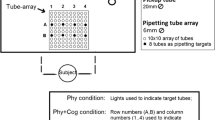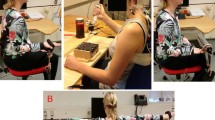Summary
The use was explored of psychomotor tests as indicators of the risk of shoulder-neck disorders in workers with low-level static loads on the shoulder muscles. Two groups of workers performing office work and light production work were studied. A muscle coordination test with continuous movement of the arm and hand between three target areas and a psychogenic tension test, posing mental demands and with minimal requirement for body movements, aimed to quantify muscle activity in excess of that needed for biomechanical purposes. The electromyogram (EMG) recording of the active trapezius muscle in the muscle coordination test correlated with the median and static EMG values of the vocational (i.e. during the normal work task) trapezius recording both for the office and production workers, but showed no correlation with shoulder-neck complaints. The EMG responses in the psychogenic tension test and of the passive (contralateral) trapezius in the muscle coordination test correlated best with the parameters showing short, spontaneous pauses in the EMG recording of occupational load. For the office workers, but not for the production workers these parameters also correlated with shoulder-neck complaints and the presence of psychosocial problems. Psychomotor tests may thus be useful as indicators of the risk of shoulder-neck complaints in certain occupations, but further experimentation is needed to validate this conclusion.
Similar content being viewed by others
References
Aarås A (1987) Postural load and the development of musculoskeletal illness (Dissertation). Scand J Rehabil Med [Suppl 18]
Aarås A, Stranden E (1988) Measurement of postural angles during work. Ergonomics 31:935–944
Balshan ID (1962) Muscle tension and personality in women. Arch Gen Psychiatry 7:436–448
Davis RC (1938) The relation of muscle action potentials to difficulty and frustration. J Exp Psychol 23:141–158
Davis RC (1939) Patterns of muscular activity during ‘mental work’ and their constancy. J Exp Psychol 24:451–465
Edwards RHT (1988) Hypotheses of periferal and central mechanisms underlying occupational muscle pain and injury. Eur J Appl Physiol 57:275–281
Hagberg M, Wegman DH (1987) Prevalence rates and odds ratios of shoulder-neck diseases in different occupational groups. Br J Ind Med 44:602–610
Jensen C, Nilsen K, Hansen K, Westgaard RH (1993) Trapezius muscle load as a risk indicator for occupational shoulder-neck complaints. Int Arch Occup Environ Health 64:415–423
Jonsson B (1978) Kinesiology — with special reference to electromyographic kinesiology. Contemp Clin Neurophysiol 34:417–428
Jonnson B (1982) Measurement and evaluation of local muscular strain in the shoulder during constrained work. J Hum Ergol 11:73–88
Kamwendo K, Linton SJ, Moritz U (1991) Neck and shoulder disorders in medical secretaries. Scand J Rehabil Med 23:57–63
Larsson S-E, Bengtsson A, Bodegård L, Henriksson KG, Larsson J (1988) Muscle changes in work related chronic myalgia. Acta Orthop Scand 59:552–556
Larsson S-E, Bodegård L, Henriksson KG, Öberg PÅ (1990) Chronic trapezius myalgia. Morphology and blood flow studied in 17 patients. Acta Orthop Scand 61:394–398
Linton SJ, Kamwendo K (1989) Risk factors in the psychosocial work environment for neck and shoulder pain in secretaries. J Occup Med 31:609–613
Luopajärvi T, Kuorinka I, Virolainen M, Holmberg M (1979) Prevalence of tenosynovitis and other injuries of the upper extremities in repetitive work. Scand J Work Environ Health 5:48–55 [Suppl 3]
Sainsbury P, Gibson JG (1954) Symptoms of anxiety and the accompanying physiological changes in the muscular system. J Neurol Neurosurg Psychiat 17:216–224
Veiersted KB, Westgaard RH, Andersen P (1990) Pattern of muscle activity during stereotyped work and its relation to muscle pain. Int Arch Occup Environ Health 62:31–41
Veiersted KB, Westgaard RH, Andersen P (1993) Electromyographic evaluation of muscular work pattern as a predictor of trapezius myalgia. Scand J Work Environ Health (in press)
Wærsted M, Bjørklund RA, Westgaard RH (1991) Shoulder muscle tension induced by two VDU-based tasks of different complexity. Ergonomics 34:137–150
Wærsted M, Bjørklund RA, Westgaard RH (1993a) The effect of motivation on shoulder-muscle tension in attention-demanding tasks. Ergonomics (in press)
Wærsted M, Eken T, Westgaard RH (1993b) Psychogenic motor unit activity: a possible muscle injury mechanism studied in a healthy subject. J of Musculoskelet Pain (in press)
Weber A, Fussler C, O'Hanlon JF, Gierer R, Grandjean E (1980) Psychophysiological effects of repetitive tasks. Ergonomics 23:1033–1046
Westgaard RH (1988) Measurement and evaluation of postural load in occupational work situations. Eur J Appl Physiol 37:291–304
Westgaard RH, Bjørklund R (1987) Generation of muscle tension additional to postural muscle load. Ergonomics 34:911–923
Westgaard RH, Jansen T (1992a) Individual and work related factors associated with symptoms of musculoskeletal complaints. I A quantitative registration system. Br J Ind Med 49:147–153
Westgaard RH, Jansen T (1992b) Individual and work related factors associated with symptoms of musculoskeletal complaints. II Different risk factors among sewing machine operators. Br J Ind Med 49:154–162
Westgaard RH, Jensen C, Hansen K (1993) Individual and work related risk factors associated with symptoms of musculoskeletal complaints. Int Arch Occup Environ Health 64:405–413
Winkel J, Westgaard R (1992) Occupational and individual risk factors for shoulder-neck complaints. Int J Ind Ergonomics 10:79–104
Zipp P (1982) Recommendations for the standardization of lead positions in surface electromyography. Eur J Appl Physiol 50:41–54
Author information
Authors and Affiliations
Rights and permissions
About this article
Cite this article
Westgard, R.H., Jensen, C. & Nilsen, K. Muscle coordination and choice-reaction time tests as indicators of occupational muscle load and shoulder-neck complaints. Europ. J. Appl. Physiol. 67, 106–114 (1993). https://doi.org/10.1007/BF00376652
Accepted:
Issue Date:
DOI: https://doi.org/10.1007/BF00376652




